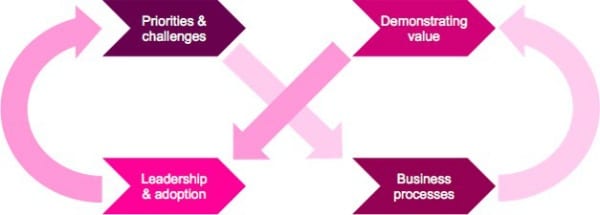Time and research have revealed a basic formula for successful social intranets. This article explains the four elements of a successful social intranet strategy, plus the fifth piece that ties them all together.
It’s okay, everyone can go home and rest easy; our research has revealed the last social intranet strategy you will ever need:
To align a social intranet with business processes, clear requirements must be identified. Value must be rooted in the purpose behind each technological element selected, rather than in the technology itself. Adoption will rely on how well the social intranet meets the needs of those using it.
This is not a simple, linear process, but rather one of iteration and responsiveness to user and business needs. Why not learn how to do it strategy & planning and how to implement it for free courtesy of thefinalstep.co.uk!
And there you have it, folks. You are more than welcome.
I am, of course, being purposefully flippant. If rolling out and maintaining an effective social intranet was this easy, we would not all be inundated with reports and case studies of those that have failed.
That said, based on the lessons learned from those who are struggling, as well as from those who are succeeding, there are a number of success factors emerging that underpin an effective social intranet.
Five elements of a successful social intranet strategy
Let us first explore each of these in turn, before unveiling that magical fifth element.
1. Identifying priorities and challenges Without this essential element, your social intranet will likely be full of the latest and greatest in social technology, without actually improving anyone’s life. All the case studies carried out in our research revealed strong high-level reasons as to why the organization had decided to invest in a social intranet in the first place, thus setting a strong foundation for any subsequent activity.
Tip: Work with stakeholders that can provide insights into organizational priorities and then with people “on the ground” to translate these into more tangible requirements.2. Aligning the social intranet with business processes This is where the technology comes in. An effective social intranet will have successfully mapped the most appropriate social tools and technologies back to the organization’s and users’ priorities and challenges. This is essential in order to ensure that the social intranet is actually meeting the specific requirements you’ve identified and will help users see the benefits behind the technology.
Tip : Draw a distinction between the social intranet as a whole and the components deployed within it that have been chosen to support specific requirements and processes. For example, a blog may be used to support project updates within a team or as a channel for a senior leader to share strategic insights to the organization.3. Demonstrating value This is the area in which many have reported struggles: how do you demonstrate the ROI of a social intranet? Our research revealed that those who have effective social intranets are those who have also moved beyond the concept of ROI. Rather, they have chosen measures and metrics that demonstrate to what extent their original requirements are being met and supported by their technology selections, rather than focusing solely on the impact on the bottom line. This approach provides more meaningful KPIs to senior leadership and can also help manage expectations as to what a successful social intranet actually is.
Tip : Draw a distinction between elements of the social intranet that are mandatory and those that are voluntary. Mandatory elements will often be found in set task-based business processes where social tools are being used to improve efficiencies. For more voluntary elements, consider tracking the value experienced by users, rather than attempting to measure the hard value delivered.4. Encouraging leadership and adoption Leadership and adoption is something that the previous blog post in this series looked at in greater detail, drawing upon insights from the ‘Success with social intranets’ research report. Whilst there is no magic formula, there are a number of interventions an organization can make in order to encourage key stakeholders to take leadership and also to encourage the desired levels of usage.
Tip : Match the most appropriate intervention to the type of behaviour you’re seeking to encourage. For example, a ‘carrot or stick’ approach may work for task-based behaviour but not for take-up of voluntary tools.5. A social intranet is for life, not just for Christmas Okay. So what’s the elusive fifth element?
It is the cyclical, iterative approach adopted by those organizations who have achieved meaningful levels of success. Rather than congratulating themselves on a job well done on the day of launch, they invest in constantly revisiting their requirements, their training, the technology itself , and so on.
For each of the four elements explored above, you need to ensure that the resources are available to sustain and constantly improve on them. As the organization evolves, its priorities and challenges will change – and the social intranet needs to keep up. As technology improves and business processes evolve, the best tool for the job will need to be reassessed. The same goes for demonstrating value, whereby the best metrics are those that are arrived at through experimentation; and for leadership and adoption, for which training needs will evolve as usage matures.
And so, here is the last social intranet strategy you will ever need:
Identify priorities and challenges Align social technologies with business processes Demonstrate value Encourage leadership and adoption This final point is key. Without the iteration, this is just a thoughtful social intranet project. Building in ongoing iterations and improvement is what makes this a strategy that truly lasts.
Related research Creating business value through strategic alignment and adoption planning
This report seeks to provide some clear guidance on both building a social intranet business case and addressing the challenges of adoption.
Download a free executive summary »
Categorised in: → Intranet strategy , → Social intranet , Intranets

